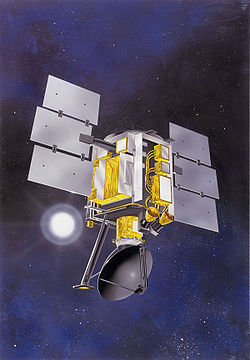- QuikSCAT
-
QuikSCAT 
Typ: Forschungssatellit Land: USA Behörde: NASA NSSDC ID: 1999-034A Missionsdaten Start: 20. Juni 1999, 02:15 UTC Startplatz: Vandenberg AFB SLC-4W Trägerrakete: Titan II Status: inaktiv Bahndaten Umlaufzeit: 100,93 min Bahnneigung: 98,6° Apogäum: 815 km Perigäum: 281 km Exzentrizität: 0,00014 QuikSCAT (Abkürzung von Quick Scatterometer) ist ein Erdbeobachtungssatellit der NASA, dessen Aufgabe es ist, für die NOAA Informationen über die die Windgeschwindigkeit und -richtung über den Ozeanen zu sammeln. Die Mission wurde kurzfristig ins Leben gerufen, da das NSCAT-Instrument an Bord des japanischen ADEOS-I-Satelliten auf Grund eines Energieausfalls seit Juni 1997 keine Daten mehr übertrug. QuikSCAT wurde am 20. Juni 1999 mit einer Titan II von der Vandenberg Air Force Base in eine sonnensynchrone Erdumlaufbahn gebracht.
QuikSCAT ist Teil des Earth Observing Systems, einem längerfristigen Forschungsprogramm der NASA.
Obwohl für eine zweijährige Lebensdauer ausgelegt funktionierte QuikSCAT über zehn Jahre lang, bis am 23. November 2009 der Mechanismus zur Rotation der Scatterometer-Antenne ausfiel.[1]
Siehe auch
Weblinks
- Homepage des QuikSCAT-Satelliten (englisch)
Einzelnachweise
- ↑ Spaceflight Now: Wind sensor failure ends long-lived satellite mission
Zum Forschungsprogramm Earth Observing System (EOS) der NASA gehörende MissionenSeaWiFS · TRMM · Landsat 7 · QuikSCAT · Terra · ACRIMSat · NMP/EO-1 · Jason-1 · Sage III · GRACE · Aqua · ADEOS-II/Midori-II · ICESat · SORCE · Aura · CloudSat · CALIPSO · OCO · Glory · OSTM · Aquarius · NPOESS Preparatory Project · ESSP · NMP/EO-3
Wikimedia Foundation.
Schlagen Sie auch in anderen Wörterbüchern nach:
Quikscat — QuickSCAT Le QuikSCAT (Quick Scatterometer) est un satellite d observation terrestre qui fournit des informations sur la vitesse et la direction des vents sur les océans au NOAA. Il est l engin de secours destiné à fournir les informations… … Wikipédia en Français
QuikSCAT — Saltar a navegación, búsqueda QuickSCAT QuickSCAT Organización NASA Estado Activo … Wikipedia Español
QuikSCAT — The QuikSCAT (Quick Scatterometer) is an earth observing satellite that provides wind speed and direction information over oceans to NOAA. It is a quick recovery mission to fill the gap created by the loss of data from the NASA Scatterometer… … Wikipedia
QuikSCAT — QuickSCAT Le QuikSCAT (Quick Scatterometer) est un satellite d observation terrestre qui fournit des informations sur la vitesse et la direction des vents sur les océans au NOAA. Il est l engin de secours destiné à fournir les informations… … Wikipédia en Français
Quick Scatterometer — QuikSCAT Typ: Forschungssatellit Land (Organisation): USA (NASA) Missionsdaten Trägerrakete: Titan II … Deutsch Wikipedia
Erdbeobachtungssystem — Das Earth Observing System (englisch für Erdbeobachtungssystem), kurz EOS, ist ein Forschungsprogramm der NASA, zu dem eine Reihe künstlicher Satelliten mit wissenschaftlichen Instrumenten im Erdorbit gehören. Diese Erdbeobachtungssatelliten… … Deutsch Wikipedia
Ocean Prediction Center — OPC pressure forecast valid at 48 hours The Ocean Prediction Center (OPC), established in 1995, is one of the National Centers for Environmental Prediction’s (NCEP’s) original six service centers.[1] Until January 12, 2003, the name of the… … Wikipedia
Liste der Erdbeobachtungssatelliten — Das ist die Liste der Erdbeobachtungssatelliten. Chronologische Übersicht (unvollständig) Inhaltsverzeichnis: 1960er · 1970er · 1980er · 1990er · 2000er · 2010er Startdatum Mission Bild Organisation (Land) Bemerkung 1960er … Deutsch Wikipedia
Atlantic hurricane reanalysis — is an ongoing project within the National Oceanic and Atmospheric Administration which seeks to correct and add new information about past Atlantic tropical cyclones. It was started around 2000 to update HURDAT, the official hurricane database… … Wikipedia
List of storms in the 2007 Atlantic hurricane season — The 2007 Atlantic hurricane season was an event in the annual cycle of tropical cyclone formation. It officially started June 1, 2007, and ended November 30, 2007, dates that conventionally delimit the period when most tropical cyclones form in… … Wikipedia

